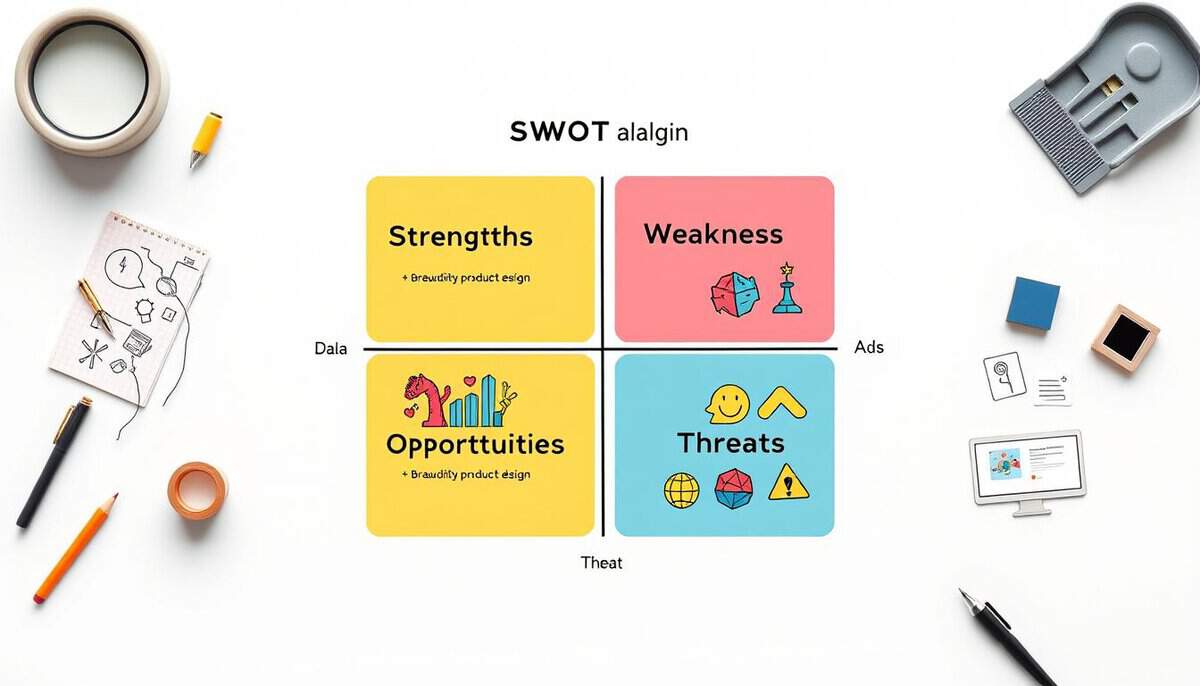Ever wondered why top brands always beat their rivals in product design? They use a strategic tool known as SWOT analysis. This guide will show you how SWOT analysis in product design leads to innovation and efficiency.
SWOT analysis helps understand both the strong points, like an intuitive user interface, and the weak ones, such as slow loading times. It helps teams grab opportunities and handle threats. As markets and customer needs change, relying on SWOT keeps your design strategies competitive and innovative. Let’s explore how this framework is key in strategic product design, ensuring you stay ahead and satisfy users.
Key Takeaways
- SWOT analysis aids in evaluating internal and external factors affecting product design.
- Regularly updated SWOT analysis keeps design strategies aligned with market trends.
- User satisfaction and performance metrics are crucial for identifying design strengths.
- Cross-functional collaboration enhances the SWOT analysis process in product development.
- Opportunities for design improvement can be explored through competitive analysis and monitoring technological advancements.
What is SWOT Analysis?
Do you want to grasp SWOT Analysis? It’s crucial for planning and evaluating product designs. “SWOT” stands for Strengths, Weaknesses, Opportunities, and Threats. This framework helps businesses understand their situation both inside and out.
Defining SWOT: Strengths, Weaknesses, Opportunities, and Threats
A SWOT analysis sorts factors into four categories. Strengths are what a business does well, like having a top-notch product or customer service. Weaknesses point out where a company might fall short, such as in designing products.
Opportunities look at external chances for growth, like new tech or market gaps. Threats consider outside challenges, including rivals or shifts in what customers want.
Origins and Evolution of SWOT Analysis
SWOT Analysis came about in the 1960s, thanks to Albert Humphrey’s research at Stanford. It has grown into a key tool for business strategy and product design. With time, SWOT has embraced new methods. It now uses market studies and tech trends for better insight.
Importance of SWOT Analysis in Strategic Planning
Doing a SWOT Analysis is vital for businesses looking to match their strategies with the market. It highlights what’s working and what’s not in product design. This guides key decisions. Plus, exploring various SWOT tactics lets companies get ahead. They can spot opportunities and dodge threats more effectively.
| Data Source | Contribution to SWOT Analysis |
|---|---|
| Market Research | Identifies unmet needs and opportunities |
| User Trends and Preferences | Enhances product design by staying updated on evolving preferences |
| Emerging Technologies | Incorporates innovative features addressing user pain points |
| Competitor Insights | Identifies strategies to counteract potential threats |
| User Feedback Analysis | Improves product by addressing common complaints and recurring issues |
| Usability Testing Metrics | Evaluates technical strengths and user experience |
| Collaborative Workshops | Engages diverse teams for enriched analysis |
| Competitive Benchmarking | Compares with competitors to identify improvement areas |
When to Perform SWOT Analysis in the Product Design Process
Using SWOT analysis in product design is crucial. It helps to make your product efficient and effective. And it guides your product from just an idea to a big hit in the market.
Timing and Integration with New Product Design
It’s best to use SWOT analysis at the start of designing a new product. It’s really important in the brainstorming stage. This is when we think about lots of different ideas.
This early use of SWOT helps check if ideas are good. It sees if they match what people want and what the company can do.
Looking at strengths, weaknesses, opportunities, and threats from the start helps map out a good plan. Keeping the SWOT analysis updated as the product develops helps stay flexible. This way, the product can change as needed to do well in the market.
Stages of Product Development Benefiting from SWOT Analysis
SWOT analysis is useful at different points in making a product:
- Idea generation: this filters ideas, so only the good ones that fit the market and our strengths go forward.
- Concept development: knowing weaknesses and threats helps improve the product. This happens before spending a lot of money on it.
- Market testing: keeping the SWOT in mind helps adjust the product based on what customers think and what competitors do.
- Commercialization: the final SWOT check makes sure the product can enter the market strongly. It helps plan good marketing and growth strategies.
This method highlights why it’s important to do SWOT analysis in product design. It really helps a product succeed. Here is a SWOT matrix template used for product development:
| Strengths | Weaknesses | |
|---|---|---|
| Internal Factors | Unique features Strong brand reputation | High production costs Limited market presence |
| Opportunities | Threats | |
| External Factors | Emerging market trends Customer feedback | Competitive pressures Economic downturn |
Benefits of SWOT Analysis for Product Design
SWOT analysis tools are a big plus in product design. They help improve the design from all angles. By looking at strengths, weaknesses, opportunities, and threats, designers can become more efficient, avoid risks, and innovate.
Enhancing Design Efficiency
SWOT analysis makes design work better and smoother. It shows what’s working and what’s not inside the team. For example, a strong team can be used more, and identifying slow points helps fix them.

Mitigating Risks Early in the Design Process
Using SWOT analysis early helps catch risks before they grow. It spots outside dangers and inside problems. Teams can plan to avoid these issues, reducing delays and costs.
It’s key for keeping projects on track and on time.
Boosting Innovation and Creativity
SWOT analysis also boosts new ideas. It reveals chances that might be missed otherwise. By looking at market trends and new chances, designers can break new ground.
Knowing we have a top-notch R&D team encourages even more creativity.
Implementing SWOT Analysis in Strategic Product Design
Implementing SWOT analysis in strategic product design is key to innovation and project success. By assessing internal and external factors, companies can develop effective strategies. These strategies use strengths and address potential threats.
Frameworks and Techniques
SWOT analysis becomes streamlined with structured frameworks and methods. They involve examining:
- Internal factors like core competencies, product quality, and customer satisfaction.
- External factors such as market trends, regulatory changes, and competitor analysis.
The TOWS matrix enhances SWOT analysis. It connects internal and external aspects to form actionable strategies. SWOT analysis templates also help in evaluating, communicating, and fostering teamwork among stakeholders.
Implementing SWOT analysis quickly involves a 5-minute idea session on strengths, weaknesses, opportunities, and threats. Then, using affinity mapping and dot voting, teams can prioritize these insights efficiently.
Collaborative Tools for Cross-functional Teams
Strategic product design thrives on cross-functional collaboration. SWOT analysis brings in diverse viewpoints, making the evaluation more complete. Tools that help include:
- Shared digital workspaces for real-time idea exchange.
- Interactive SWOT templates for...
You have read 35% of the article. The rest is for our community. Already a member? Log in
(and also to protect our original content from scraping bots)
Innovation.world community
Login or Register (100% free)
View the rest of this article and all members-only content and tools.
Only real engineers, manufacturers, designers, marketers professionals.
No bot, no hater, no spammer.
Related Readings & Methodologies
- PESTEL analysis: examines Political, Economic, Social, Technological, Environmental, and Legal factors that impact an organization.
- Porter’s five forces: analyzes the competitive forces within an industry to understand the intensity of competition and market profitability.
- Value chain analysis: identifies key activities within an organization that create value, focusing on optimizing each to enhance competitive advantage.
- Balanced scorecard: a strategic management tool that tracks organizational performance across financial, customer, internal processes, and learning & growth perspectives.
- BCG matrix: assesses product lines or business units based on market growth rate and market share to aid in resource allocation.
- VRIO framework: evaluates resources and capabilities to determine if they offer a sustained competitive advantage based on Value, Rarity, Imitability, and Organization.
- Ansoff matrix: guides strategic decision-making regarding market penetration, product development, market development, and diversification.
- TOWS matrix: an extension of SWOT, it helps generate strategic options by matching external opportunities and threats with internal strengths and weaknesses.
FAQ
What is SWOT Analysis?
SWOT Analysis is a tool for planning. It finds the Strengths, Weaknesses, Opportunities, and Threats of a project or business. It’s used to make better product strategies by looking at internal and external factors. It started in the 1960s and 1970s at the Stanford Research Institute. Researchers created it to help businesses know their strategic position. It has become key in planning and evaluating product design.
Why is SWOT Analysis important in strategic planning?
It’s key because it assesses a business’s internal and external environments in a structured way. This helps spot improvement areas and growth opportunities. It’s crucial for planning products and their development. It helps adapt to market changes, improve customer targeting, and develop a competitive edge. This keeps products in line with market demands and customer needs.
When should SWOT Analysis be performed in the product design process?
It should be used in the product development process, especially in the idea and pre-commercialization phases. This helps match the product with market needs and the company’s strengths. Its benefits are boosting design efficiency, reducing risks early, and increasing innovation. SWOT tools help improve product design continuously.
Implementation involves using frameworks and tools for teamwork. This helps teams identify key features and merge different perspectives into a strong product design strategy.
Glossary of Terms Used
Key Performance Indicator (KPI): a measurable value that demonstrates how effectively an organization is achieving key business objectives, often used to evaluate success at reaching targets.
User experience (UX): the overall satisfaction and perception of a user when interacting with a product, system, or service, encompassing usability, accessibility, design, and emotional response throughout the entire interaction process.
User Interface (UI): a system that enables interaction between users and software applications, encompassing visual elements, controls, and overall layout to facilitate user tasks and enhance experience.



























explore how to tailor SWOT analysis to different industries with unique challenges
it should be complemented by other methodologies like design thinking and agile development to ensure a holistic approach
What about other complementary tools like PEST analysis, which examines Political, Economic, Social, and Technological factors ?
Interesting read! Does anyone else think SWOT analysis might be too simplistic for complex product design scenarios?
Absolutely! SWOT analysis is mere child’s play in the face of complex product design.
Interesting read, but isnt SWOT analysis a bit outdated in the face of modern, fast-paced product design processes?
Outdated? SWOTs timeless insights can fuel any design, modern or not!
Really, dont you think SWOT analysis is a bit outdated for modern product design? Has anyone tried other alternatives?
Related Posts
Contamination Control Strategy & Cleanroom 26 Best Practices
From GMP to cGMP: the Full Mastering Guide
IQ OQ PQ Process Validation: Full Theory & Praxis
The “Lone Nut”, the “First Follower”, and the “Fast Follower” Strategies
Best 20 Usages of Proxies For Engineering
How to Sell Ice to Eskimos (aka Marketing Shenanigans)